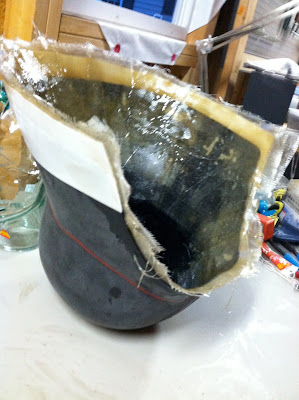Materials Needed:
- Fiberglass Resin (the big metal container)
- Fiberglass Cloth (Not shown in this pic)
- Fiberglass Liquid Hardener (The tiny tube)
(These can usually be bought together in a kit. This kit is 3M from Lowes. brand and such doesn't matter for this quick rundown. - Cups/containers to MIX the stuff in. I'm using the red plastic cups
- Popsicle Sticks / Stirrers to stir mix
- A paintbrush you REALLY do not want to keep. (Those 59 cent ones at the bottom of the shelf!)
- Something to cover your work surface with. I prefer cardboard as it is less likely to have the resin soak through. I have forgotten to use it in this example!
- Scissors.. not your wifes/husbands favorite ones. (Ok i stole them from the kitchen but the next day I bought her a brand new set!)
SAFETY ESSENTIALS!
Because you dont want to inhale THIS
Fiberglass cloth is.. well I'm not sure if its really glass or what, but its definitely tiny microscopic strands of something, and its really really bad for your lungs. You don't want to breath it.
- Safety Mask/Respirator - this is number one. This stuff is probably as bad for you as inhaling asbestos.
- Rubber Gloves
- VENTILATION - The resin stinks and cannot be healthy. I do this in the garage with both doors open, then when done i do not dawdle there...
- Safety Goggles - if you think you need them, I'm not your mom. :)
The process is fairly straightforward...
- Decide what you want to cover with fiberglass
- Mix your resin and hardener. this starts the time clock. You have until the mix is unusable thick (the hardener has begun working!)
- Place the cloth where you want it to be.
- Paint the resin/hardener mix (henceforth just resin..) onto the cloth.
- With More Pieces of cloth, repeat steps 3 and until you are done, out of cloth, or your resin is too think to be workable.
- Get the heck out of the room, this stuff stinks!

So lets take a look at the process in detail now that I've done an overview.
Cut Up Your Fiberglass Strips
Using scissors you do not value very highly, Cut the fiberglass cloth into strips or rectagles or squares (or irregular polygons... whatever)
I do this step before i get the resin out because it cures quickly. You definitely need your mask on here. these microscopic shards are now flying through the air. YUM! Dont get them in your mouth.
Everything is Ready to go
I am working on reinforcing the inside of my Rubie's Darth Vader helmet with fiberglass, and extending the length of the helmet skirt. I have already roughed up the plastic with a power sander so that the resin will stick very well. It sticks better to a less smooth surface.
Here we see the helmet with the previous session of fiberglassing already done, and my cut up pieces of fiberglass cloth ready to go.
Mixing the hardener and resin
- Pour Some resin into a cup. Here i used about 8 ounces. which was too much!
- Add the amount of hardener specified on your resin's can. It will still be guesswork as the amount of a DROP is dependent on the size of what you poked a hole in the top of the hardener tube. I recommend erring toward a little too MUCH the FIRST time you do it.. then as you gain practice use less to give yourself more working time. You do not want to get into a situation where your resin never hardens.
Stir it up very very well. Very. As you can see this is a good time to have your gloves on. If you didnt have them on for cutting the cloth your hands should be good and itchy now as those microscopic shards bore into your skin... Just sayin'
Get to Work
Ok the resin is mixed and the clock is ticking.
- Place a Fiberglass cloth piece where you want it and begin coating it with the paintbrush until it is completely saturated. It will turn transparent (mostly) when saturated enough.
Continue this process with all your remaining pieces of fiberglass cloth. If you are doing this as a small repair. you may only need a few pieces and once dryed this stuff is likely to never need any more work.
The job i am doing here takes multiple layers over several days. Once done I will then be wearing even MORE protective gear and SANDING it a great deal.
FINISHED
Finished... with todays layer. I could do another layer in an hour or so but i have to go in and write a blog post.. oh.. thats now...
So I'm going to let this dry Overnight.
Another picture of the finished layer...
Well that is all there is to applying fiberglass, if you are just building something up or doing a repair.
For a fully smooth and nice finish, if it has to look good.. there are a lot more steps. I will tackle these after a few more layers inside so the edge is nice and thick like the real movie helmet.
Next Steps
- Trim the edges you see sticking out with a dremel rotary tool.
- Coat the outside in a thin layer of body filler (bondo/evercoat/etc.) Let dry.
- Sand / Prime / Identify problem areas
- Fill problem areas
- Sand / Prime / Identify problem areas
- Fill problem areas
- Sand / Prime / Identify problem areas ....
- ...
- ...
Thats it. Hopefully my first post has not bored you to tears! Have fun and don't inhale any glass fibers.










Btw.. Fiber glass is most definitely made of glass.
ReplyDeleteAhh. Yummy then. Glad I'm wearing masks
ReplyDelete